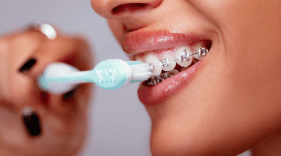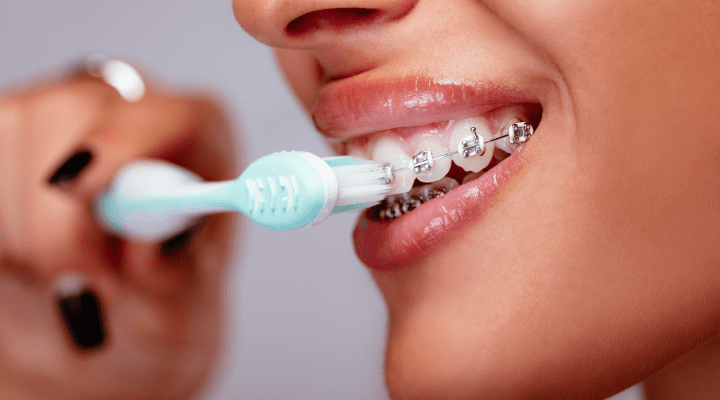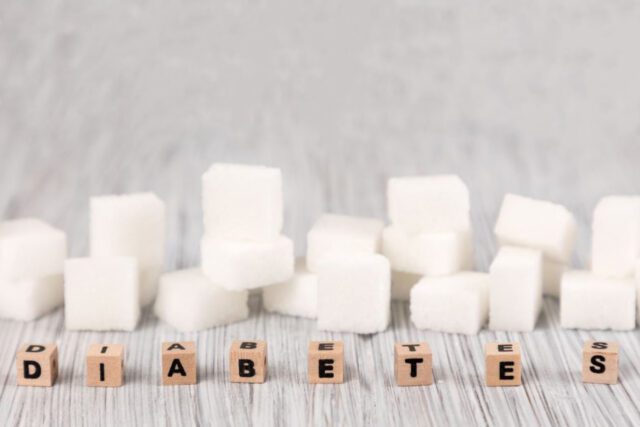Brushing Teeth with Braces | A Dentist’s Guide

Whether you or your child’s braces are on for 6 months or 2 years, it’s imperative to develop proper brushing habits right away. Braces provide far more nooks and crannies in our mouths for food and plaque to hide in, making proper brushing technique, frequency, and toothpaste crucial. While it’s always important to brush your teeth, taking extra precautions with braces will both prevent tooth decay and avoid decalcification marks. Decalcification is weakened enamel that appears as white marks on the teeth.
We spoke to Dr. Fred Eichmiller, DDS, vice president and science officer at Delta Dental of Wisconsin, for recommendations on how to best brush your teeth with braces.
What Toothpaste Should be Used with Braces?
“I recommend a fluoridated toothpaste. If someone is at high risk for cavities, we may prescribe a fluoride gel (such as PreviDent or a fluoride rinse) for use after brushing. If we suspect someone is at risk for decalcification, we may prescribe or dispense a paste that is high in calcium, phosphate, and fluoride. There are a few different products on the market such as MI paste or Re-Min paste. MI paste is milk based, so it isn’t the best for patients with dairy sensitivities or allergies.”
It’s always encouraged to consult with your dentist or orthodontist on what is best for your mouth.
Manual Toothbrush or Electric Toothbrush with Braces?
Dr. Eichmiller’s advice for most is to “use the brush that works best for you.” With that said, some electric toothbrushes have an advantage over manual toothbrushes, including a timer and special brush attachments made for braces. The best toothbrush is the one you use regularly and consistently.
How Do You Brush Your Teeth with Braces?
To start brushing, angle your toothbrush at 45 degrees. Point it between the gum line and the bracket. Dr. Eichmiller says, “this is where dental problems usually start.”
Follow this by angling the toothbrush up to reach the underside of the braces. Go slowly, making sure to brush each tooth at the gum line, and above and below each bracket.
Next, use a small proxy brush to reach areas a toothbrush may have missed. A little proxy brush is great for cleaning between teeth and wires. Don’t forget to floss! It’s easier to floss with braces with a floss threader. This device helps get the floss into the proper position between teeth and braces. It also reaches under the gums. “There are other special devices to help with flossing,” says Dr. Fred, “but anything that makes flossing easier is more likely to get someone to floss.”
Brushing after every meal is ideal, but it might not always be possible. If a toothbrush and toothpaste isn’t accessible, swish some water around your mouth to remove any food particles.
Final Tips on Braces from Dr. Eichmiller
“Because braces create more nooks and crannies for plaque to hide in and attach to, chances for decalcification and decay increase substantially.” A common rumor Dr. Eichmiller hears is that decalcification is caused by brackets against the teeth. It’s actually a misconception that the braces cause them.
“The marks, or cavities, aren’t usually under the brackets. They are next to them. Most commonly, decalcification occurs between the bracket and the gum line.”
That area is the hardest for patients to keep clean. A good analogy is carpet. If you move furniture around, you see worn parts of the carpet in high traffic areas. These high traffic areas are like decalcification.
“If you don’t keep your teeth clean, you’ll see damage under the braces from lack of care. Because patients with braces see the orthodontist every month, another misconception is they don’t need a dentist. They may actually need to see the dentist more because it’s harder to things clean with appliances.”
Patients can coordinate their cleaning with their orthodontist. That way, the orthodontist can remove arch wires and the dentist or hygienist can clean, monitor for cavities, and give personal hygiene instructions.
Learn more about caring for your braces:
Related stories
-
A Healthy Mouth with Diabetes
Whether you have type 1 or type 2 diabetes, managing your blood sugar level is key. With … Read More
-
Did pirates take care of their teeth?
When you envision a pirate, who do you think of? For many people, the fictional character Captain … Read More
-
New Online Member Portal Promotion | 2019 Prize Drawing from Delta Dental of Wisconsin
Running now through February 29, 2020, Delta Dental of Wisconsin wants you to take advantage of your new … Read More
Sign Up Now
Most Liked
- 1 Do Expiration Dates on Dental Products Matter? 305 Likes
- 2 Is Activated Charcoal Safe for your Smile? 167 Likes
- 3 Crazy and Cool Fish Teeth Facts 92 Likes
- 4 What Are Tonsil Stones? 81 Likes
- 5 Delta Dental Protects Your Eyes with DeltaVision® Coverage 74 Likes
- 6 The In-between Tooth: Guide to Bicuspids 53 Likes
- 7 Recipe: Quick Pumpkin Pudding 49 Likes
- 8 Bad Taste After Brushing? Common Explanations 44 Likes
- 9 People with Dental Benefits are Healthier 40 Likes
- 10 Own Your Oral Health: Subscribe now for tips to ensure a bright smile 39 Likes




